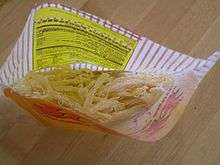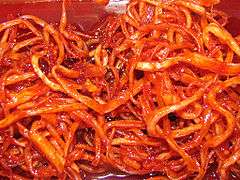Dried shredded squid
| Dried shredded squid | |||||||||||||||
 | |||||||||||||||
| Chinese name | |||||||||||||||
|---|---|---|---|---|---|---|---|---|---|---|---|---|---|---|---|
| Traditional Chinese | 魷魚絲 (by strand) | ||||||||||||||
| Simplified Chinese | 鱿鱼丝 | ||||||||||||||
| Hanyu Pinyin | yóu yú sī | ||||||||||||||
| Cantonese Jyutping | jau4 jyu4*2 si1 | ||||||||||||||
| Literal meaning | squid strand | ||||||||||||||
| |||||||||||||||
| Alternative Chinese name | |||||||||||||||
| Traditional Chinese | 魷魚片 (by slice) | ||||||||||||||
| Simplified Chinese | 鱿鱼片 | ||||||||||||||
| Hanyu Pinyin | yóu yú piàn | ||||||||||||||
| Cantonese Jyutping | jau4 jyu4*2 pin3 | ||||||||||||||
| |||||||||||||||
| Korean name | |||||||||||||||
| Hangul | 오징어채 | ||||||||||||||
| |||||||||||||||
| Japanese name | |||||||||||||||
| Kanji | 鯣 | ||||||||||||||
| Kana | スルメ | ||||||||||||||
| |||||||||||||||
Dried shredded squid is a dried, shredded, seasoned, seafood product, made from squid or cuttlefish, commonly found in coastal Asian countries, Russia, and Hawaii. The snack is also referred to as dried shredded cuttlefish.
History and origins
Historically, squid is common in Pacific coastal regions of East Asia and Southeast Asia. Only after the packaged form began shipping to English speaking regions, did the translated English-language name "dried shredded squid" get imprinted on packages. The snack was popularized, sold and consumed regularly in Hong Kong during the 1970s. Shredded squid began being sold in Macau as an addition to their almond biscuit. In China, it is usually considered to be a light snack and it is sold in bags in many department stores in major cities. In Japan, dried shredded squid is popularly served as an otsumami (snack consumed while drinking alcohol). In Korean cuisine, dried shredded squid is eaten as anju (food to eat while drinking), and as banchan (small side dishes) such as the dish ojingeochae bokkeum, which is made by stir-frying shredded dried squid seasoned with a mixture of gochujang (chili pepper paste), garlics, and mulyeot (corn syrup-like condiment).[1]
Preparation


Northern Pacific squid is separated into different parts and skinned, cooked at 65-80 °C for 3–5 minutes, cooled, grated and seasoned at a temperature below 20 °C for more than 4 hours. Sugar, salt, sorbitol, sweeteners, organic acid and MSG are typical additives.[2] They are then dried at 40-45 °C for 12–20 hours until it reaches a moisture level of 40%. It is then aged in a cold room for 2 weeks or longer, then dried at a higher temperature of 110-120 °C for 3–5 minutes.[2] It is then machine-shredded and seasoned for a second time, dried again to a reduced moisture level of 25-27%. At this phase, the color is yellow or brownish. The amino acids on the squid are revealed by the increase in brown color over prolonged storage time. Vacuum packaging or nitrogen-filled packaging also increase browning. Consumers generally do not want excessive browning.[2]
Packaging
The most common distribution method in today's Asian countries is the pre-packaged format. The bags are usually sealed airtight to keep the squid chewy and tough. Depending on the company doing the packaging or preparation, each brand usually have their own ratio of MSG added on top.
Unpackaged versions are much more rare as they have traditionally been available in select specialty shops, usually sold next to beef jerky.
Contamination
News reports have claimed that arsenic and other toxic metals have been found in DSS packaged in Hong Kong.[3]
See also
References
- ↑ https://web.archive.org/web/20090215050848/http://channel.patzzi.joins.com/article/article_dynamic.asp?aid=7514&Serv=food&Sect1=cook&Cont=
- 1 2 3 Doe, Peter E. [1998] (1998). Fish Drying and Smoking: Production and quality. CRC Press. ISBN 1-56676-668-0
- ↑ News Sina. "News Sina." Hong Kong shredded squid has arsenic. Retrieved on 2007-06-08.
